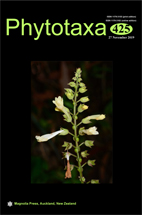Abstract
During an exploration of plant pathogens in vegetables occuring in Zhejiang province, China, a novel fungal species, was found. Three strains ZJUP0033-4, ZJUP0038-3 and ZJUP0132 were isolated from black round lesions in the stems and leaves of Amaranthus sp. Phylogenetic analyses based on sequences from four genes including rDNA internal transcribed spacer (ITS), translation elongation factor 1-α (EF1-α), histone (HIS) and β-tubulin (TUB) indicated that D. sinensis clustered in a distinct clade closely related to D. neoarctii, D. angelicae, D. subordinaria, D. arctii, D. cuppatea, D. lusitanicae, D. novem, D. infecunda, D. ganjae and D. manihotia. Morphologically, D. sinensis is distinguished by brown, scattered, globose pycnidia and ellipsoid alpha conidia with bi- to multiguttulate.

